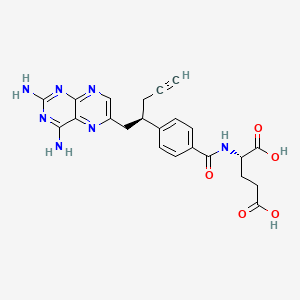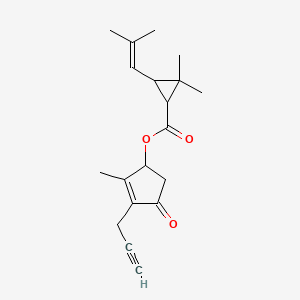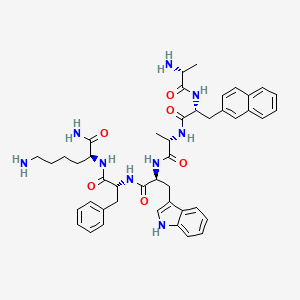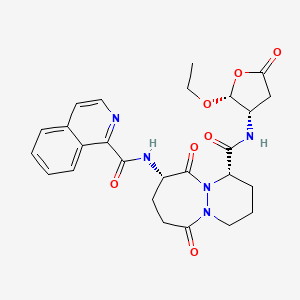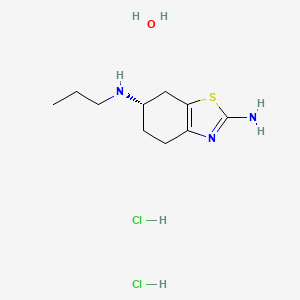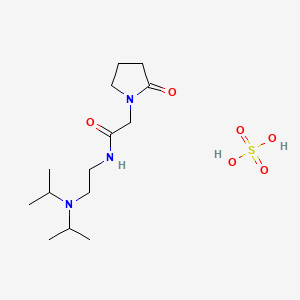
Primaquine phosphate
Overview
Description
Primaquine phosphate is a synthetic compound with potent antimalarial activity. It is primarily used to treat and prevent malaria caused by Plasmodium vivax and Plasmodium ovale . This compound is an 8-aminoquinoline compound that eliminates tissue (exoerythrocytic) infection, thereby preventing the development of the blood (erythrocytic) forms of the parasite . It is also used to treat Pneumocystis pneumonia in combination with other medications .
Mechanism of Action
Target of Action
Primaquine phosphate, an 8-aminoquinoline compound, primarily targets the Plasmodium vivax and Plasmodium ovale parasites . These parasites are responsible for causing malaria, and Primaquine is used to prevent relapse of these types of malaria . The drug acts by interfering with a part of the parasite (mitochondria) that is responsible for supplying it with energy .
Mode of Action
It may be acting by generating reactive oxygen species or by interfering with the electron transport in the parasite . Without energy, the parasite dies, stopping the infection from continuing and allowing the person to recover .
Pharmacokinetics
Primaquine exhibits a rapid tissue distribution and clearance from the plasma, with peak plasma concentrations occurring approximately 1–3 hr after oral ingestion and falling to negligible levels by 24 hr . Primaquine is well-absorbed in the gut and extensively distributed in the body without accumulating in red blood cells . The pharmacokinetic properties of Primaquine can be described by one-compartment disposition kinetics with a transit-absorption model .
Result of Action
The primary result of Primaquine’s action is the prevention of relapse in vivax malaria . By interfering with the parasite’s energy supply, Primaquine causes the parasite to die, thereby stopping the infection and allowing the person to recover . Primaquine is also used to prevent transmission of falciparum malaria .
Action Environment
The efficacy of Primaquine can be influenced by several environmental factors. For instance, the presence of food or grapefruit juice increases its oral bioavailability . Additionally, the drug’s efficacy can be affected by the individual’s metabolic characteristics, such as the presence of certain enzymes.
Preparation Methods
Synthetic Routes and Reaction Conditions
Primaquine phosphate is synthesized through a series of chemical reactions starting from 8-aminoquinoline. The reaction conditions typically involve the use of strong bases and organic solvents to facilitate the substitution reactions .
Industrial Production Methods
Industrial production of this compound involves large-scale synthesis using optimized reaction conditions to ensure high yield and purity. The process includes the purification of the final product through crystallization and filtration techniques .
Chemical Reactions Analysis
Types of Reactions
Primaquine phosphate undergoes various chemical reactions, including oxidation, reduction, and substitution .
Common Reagents and Conditions
Reduction: Reducing agents like sodium borohydride and lithium aluminum hydride are employed to reduce the compound.
Substitution: Substitution reactions involve the use of nucleophiles such as amines and thiols under basic conditions.
Major Products Formed
The major products formed from these reactions include hydroxylated and aminated derivatives of this compound .
Scientific Research Applications
Primaquine phosphate has a wide range of scientific research applications:
Comparison with Similar Compounds
Similar Compounds
Tafenoquine: Another 8-aminoquinoline compound with similar antimalarial properties.
Chloroquine: A 4-aminoquinoline compound used to treat malaria.
Mefloquine: An arylamino alcohol compound used as an antimalarial.
Uniqueness
Primaquine phosphate is unique in its ability to eliminate the dormant liver forms of the malaria parasite, preventing relapse . This property makes it an essential component of malaria treatment regimens, especially for Plasmodium vivax and Plasmodium ovale infections .
Properties
IUPAC Name |
4-N-(6-methoxyquinolin-8-yl)pentane-1,4-diamine;phosphoric acid | |
|---|---|---|
| Source | PubChem | |
| URL | https://pubchem.ncbi.nlm.nih.gov | |
| Description | Data deposited in or computed by PubChem | |
InChI |
InChI=1S/C15H21N3O.2H3O4P/c1-11(5-3-7-16)18-14-10-13(19-2)9-12-6-4-8-17-15(12)14;2*1-5(2,3)4/h4,6,8-11,18H,3,5,7,16H2,1-2H3;2*(H3,1,2,3,4) | |
| Source | PubChem | |
| URL | https://pubchem.ncbi.nlm.nih.gov | |
| Description | Data deposited in or computed by PubChem | |
InChI Key |
GJOHLWZHWQUKAU-UHFFFAOYSA-N | |
| Source | PubChem | |
| URL | https://pubchem.ncbi.nlm.nih.gov | |
| Description | Data deposited in or computed by PubChem | |
Canonical SMILES |
CC(CCCN)NC1=C2C(=CC(=C1)OC)C=CC=N2.OP(=O)(O)O.OP(=O)(O)O | |
| Source | PubChem | |
| URL | https://pubchem.ncbi.nlm.nih.gov | |
| Description | Data deposited in or computed by PubChem | |
Molecular Formula |
C15H27N3O9P2 | |
| Source | PubChem | |
| URL | https://pubchem.ncbi.nlm.nih.gov | |
| Description | Data deposited in or computed by PubChem | |
Related CAS |
90-34-6 (Parent) | |
| Record name | Primaquine phosphate [USP] | |
| Source | ChemIDplus | |
| URL | https://pubchem.ncbi.nlm.nih.gov/substance/?source=chemidplus&sourceid=0000063456 | |
| Description | ChemIDplus is a free, web search system that provides access to the structure and nomenclature authority files used for the identification of chemical substances cited in National Library of Medicine (NLM) databases, including the TOXNET system. | |
DSSTOX Substance ID |
DTXSID6045248 | |
| Record name | Primaquine diphosphate | |
| Source | EPA DSSTox | |
| URL | https://comptox.epa.gov/dashboard/DTXSID6045248 | |
| Description | DSSTox provides a high quality public chemistry resource for supporting improved predictive toxicology. | |
Molecular Weight |
455.34 g/mol | |
| Source | PubChem | |
| URL | https://pubchem.ncbi.nlm.nih.gov | |
| Description | Data deposited in or computed by PubChem | |
CAS No. |
63-45-6 | |
| Record name | Primaquine phosphate [USP] | |
| Source | ChemIDplus | |
| URL | https://pubchem.ncbi.nlm.nih.gov/substance/?source=chemidplus&sourceid=0000063456 | |
| Description | ChemIDplus is a free, web search system that provides access to the structure and nomenclature authority files used for the identification of chemical substances cited in National Library of Medicine (NLM) databases, including the TOXNET system. | |
| Record name | Primaquine diphosphate | |
| Source | EPA DSSTox | |
| URL | https://comptox.epa.gov/dashboard/DTXSID6045248 | |
| Description | DSSTox provides a high quality public chemistry resource for supporting improved predictive toxicology. | |
| Record name | Primaquine bis(phosphate) | |
| Source | European Chemicals Agency (ECHA) | |
| URL | https://echa.europa.eu/substance-information/-/substanceinfo/100.000.510 | |
| Description | The European Chemicals Agency (ECHA) is an agency of the European Union which is the driving force among regulatory authorities in implementing the EU's groundbreaking chemicals legislation for the benefit of human health and the environment as well as for innovation and competitiveness. | |
| Explanation | Use of the information, documents and data from the ECHA website is subject to the terms and conditions of this Legal Notice, and subject to other binding limitations provided for under applicable law, the information, documents and data made available on the ECHA website may be reproduced, distributed and/or used, totally or in part, for non-commercial purposes provided that ECHA is acknowledged as the source: "Source: European Chemicals Agency, http://echa.europa.eu/". Such acknowledgement must be included in each copy of the material. ECHA permits and encourages organisations and individuals to create links to the ECHA website under the following cumulative conditions: Links can only be made to webpages that provide a link to the Legal Notice page. | |
| Record name | PRIMAQUINE PHOSPHATE | |
| Source | FDA Global Substance Registration System (GSRS) | |
| URL | https://gsrs.ncats.nih.gov/ginas/app/beta/substances/H0982HF78B | |
| Description | The FDA Global Substance Registration System (GSRS) enables the efficient and accurate exchange of information on what substances are in regulated products. Instead of relying on names, which vary across regulatory domains, countries, and regions, the GSRS knowledge base makes it possible for substances to be defined by standardized, scientific descriptions. | |
| Explanation | Unless otherwise noted, the contents of the FDA website (www.fda.gov), both text and graphics, are not copyrighted. They are in the public domain and may be republished, reprinted and otherwise used freely by anyone without the need to obtain permission from FDA. Credit to the U.S. Food and Drug Administration as the source is appreciated but not required. | |
Retrosynthesis Analysis
AI-Powered Synthesis Planning: Our tool employs the Template_relevance Pistachio, Template_relevance Bkms_metabolic, Template_relevance Pistachio_ringbreaker, Template_relevance Reaxys, Template_relevance Reaxys_biocatalysis model, leveraging a vast database of chemical reactions to predict feasible synthetic routes.
One-Step Synthesis Focus: Specifically designed for one-step synthesis, it provides concise and direct routes for your target compounds, streamlining the synthesis process.
Accurate Predictions: Utilizing the extensive PISTACHIO, BKMS_METABOLIC, PISTACHIO_RINGBREAKER, REAXYS, REAXYS_BIOCATALYSIS database, our tool offers high-accuracy predictions, reflecting the latest in chemical research and data.
Strategy Settings
| Precursor scoring | Relevance Heuristic |
|---|---|
| Min. plausibility | 0.01 |
| Model | Template_relevance |
| Template Set | Pistachio/Bkms_metabolic/Pistachio_ringbreaker/Reaxys/Reaxys_biocatalysis |
| Top-N result to add to graph | 6 |
Feasible Synthetic Routes
Q1: What is the primary mechanism of action of Primaquine phosphate against malaria?
A1: While the exact mechanism remains unclear, this compound is known for its unique ability to target the dormant liver stage of Plasmodium vivax and Plasmodium ovale infections, called hypnozoites. [] This is crucial in preventing relapses, which are a significant challenge in treating these malaria species. []
Q2: How does this compound exert its anti-malarial effects?
A2: Several hypotheses exist regarding this compound's mechanism:
- Interference with Parasite Mitochondrial Function: It is suggested that this compound disrupts the electron transport chain in parasite mitochondria, ultimately leading to parasitic death. [, ]
- Formation of Reactive Oxygen Species: this compound may generate reactive oxygen species, causing oxidative damage within the parasite. []
- Inhibition of Parasite Nucleic Acid Synthesis: It has been proposed that this compound interferes with the synthesis of DNA and RNA in the parasite. []
Q3: What are the downstream effects of this compound on Plasmodium parasites?
A3: this compound's downstream effects are primarily linked to the proposed mechanisms mentioned above. These effects ultimately lead to the death of the parasite, effectively clearing the liver stage infection and preventing relapse.
Q4: What is the molecular formula and weight of this compound?
A4: The molecular formula of this compound is C15H21N3O·H3PO4. Its molecular weight is 365.3 g/mol.
Q5: Is there any spectroscopic data available for this compound?
A5: Yes, several studies have investigated this compound's spectroscopic properties: * FTIR spectroscopy: Used to identify characteristic functional groups and analyze potential interactions between this compound and excipients in formulations. [, ]* UV-Vis spectroscopy: Employed to assess the stability of this compound under various storage conditions. []
Q6: Does this compound exhibit any catalytic properties?
A6: While this compound is primarily recognized for its antimalarial activity, certain research explores its use as a spectrophotometric reagent for detecting trace amounts of gold. [] This application leverages this compound's ability to undergo oxidation by gold (III) ions in a sulfuric acid medium, forming a colored radical measurable at 550 nm.
Q7: Have there been any computational studies on this compound?
A7: While limited information is available on comprehensive computational modeling of this compound itself, some studies have focused on calculating physical parameters like molecular polarizability, diamagnetic susceptibility, and molecular electron ionization cross-section (Q). [] These parameters have been explored for potential correlations with drug activity, plasma protein binding, bioavailability, and dosage.
Q8: What formulation strategies have been investigated to enhance this compound's stability, solubility, or bioavailability?
A8: Several approaches have been explored to optimize this compound delivery:
- Solid Dispersions: Formulating this compound as a solid dispersion using carriers like mono ammonium glycyrrhizinate pentahydrate has been shown to effectively mask its bitter taste while also enhancing dissolution and potentially improving bioavailability. [, ]
- Nanoparticles: Encapsulating this compound within nanoparticles, such as PLGA nanoparticles and PEGylated galactosylated nano lipid carriers, has shown promise in enhancing drug loading, prolonging drug release, and potentially improving its targeting to the liver. [, ] These strategies aim to improve the drug's therapeutic efficacy and minimize potential side effects.
Q9: What are the key considerations for Safety, Health, and Environment (SHE) regulations concerning this compound?
A9: While the provided excerpts do not explicitly detail SHE regulations, responsible handling and disposal of this compound are crucial due to its potential environmental impacts.
Q10: What is the pharmacokinetic profile of this compound?
A10: this compound exhibits a relatively short half-life, necessitating frequent administration and potentially contributing to adverse effects and patient non-compliance. [] Various studies highlighted the pharmacokinetic properties of this compound:
- Absorption and Metabolism: this compound is well-absorbed after oral administration, and its metabolism involves the cytochrome P450 enzyme, particularly CYP2D6. []
- Bioavailability and Distribution: Studies have explored methods to improve this compound's bioavailability and target its delivery to the liver, the primary site of hypnozoite residence. []
- Excretion: The drug and its metabolites are primarily excreted in the urine. []
Q11: What is the relationship between this compound's pharmacokinetics and its pharmacodynamics?
A11: Research indicates a link between impaired CYP2D6 activity and decreased efficacy of this compound in achieving radical cure for P. vivax malaria. [] Individuals with compromised CYP2D6 activity, either due to genetic variations or drug interactions, may experience a higher risk of relapse.
Q12: What evidence supports the in vitro and in vivo efficacy of this compound?
A12: * In vitro: Studies demonstrate this compound's efficacy against Toxoplasma gondii tachyzoites in vitro, inhibiting their growth at specific concentrations. []* In vivo: In animal models, specifically Plasmodium berghei-infected mice, this compound formulated as solid lipid nanoparticles exhibited enhanced effectiveness compared to conventional oral doses. [] This highlights the potential of nanoformulations in improving the drug's therapeutic index.
Q13: What are the known mechanisms of resistance to this compound?
A13: While the precise mechanisms of resistance to this compound are not fully understood, they are thought to involve alterations in parasite drug uptake, drug target modifications, or enhanced detoxification pathways. []
Q14: Is there evidence of cross-resistance between this compound and other antimalarials?
A14: Although the provided excerpts do not directly address cross-resistance, it's a concern with antimalarial drugs. The emergence of resistance to one antimalarial can potentially reduce the efficacy of others with similar mechanisms of action.
Q15: What are the known toxicological effects and safety concerns associated with this compound?
A15: this compound can cause hemolytic anemia, particularly in individuals with glucose-6-phosphate dehydrogenase (G6PD) deficiency. [, , , ] Screening for G6PD deficiency before this compound administration is crucial to prevent this serious adverse effect. []
Q16: What drug delivery strategies have been explored to improve this compound's targeting to the liver?
A16: Researchers are investigating nanocarriers, like galactose-anchored gelatin nanoparticles, to specifically deliver this compound to the liver. [] This approach exploits the asialoglycoprotein receptor expressed on hepatocytes for targeted drug delivery.
Q17: Are there any biomarkers associated with this compound efficacy or toxicity?
A17: CYP2D6 genotype and phenotype can serve as biomarkers to predict the efficacy of this compound. Impaired CYP2D6 activity is linked to a higher relapse risk, indicating potential treatment failure. [] G6PD deficiency is a crucial biomarker for this compound-induced hemolytic anemia. [, , , ]
Q18: What analytical techniques are commonly employed in this compound research?
A18: Several analytical methods are crucial in this compound research:* High-Performance Liquid Chromatography (HPLC): A primary technique for quantitative determination of this compound in various matrices, including tablets, biological samples, and formulations. [, , , ]* Spectrophotometry: Employed to determine this compound concentrations by measuring the absorbance of colored complexes formed with specific reagents. [, , , ]* Dissolution Testing: Used to evaluate the release rate of this compound from various formulations, such as tablets, and assess how different factors impact its dissolution profile. []
Q19: Are there any viable alternatives or substitutes for this compound in treating malaria?
A19: While this compound remains a crucial drug for preventing relapse in specific malaria species, researchers are exploring alternative therapies: * Tafenoquine: A single-dose 8-aminoquinoline antimalarial drug with a longer half-life than this compound, potentially improving patient adherence. []
Disclaimer and Information on In-Vitro Research Products
Please be aware that all articles and product information presented on BenchChem are intended solely for informational purposes. The products available for purchase on BenchChem are specifically designed for in-vitro studies, which are conducted outside of living organisms. In-vitro studies, derived from the Latin term "in glass," involve experiments performed in controlled laboratory settings using cells or tissues. It is important to note that these products are not categorized as medicines or drugs, and they have not received approval from the FDA for the prevention, treatment, or cure of any medical condition, ailment, or disease. We must emphasize that any form of bodily introduction of these products into humans or animals is strictly prohibited by law. It is essential to adhere to these guidelines to ensure compliance with legal and ethical standards in research and experimentation.



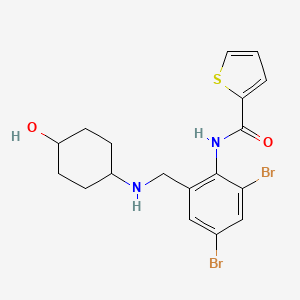

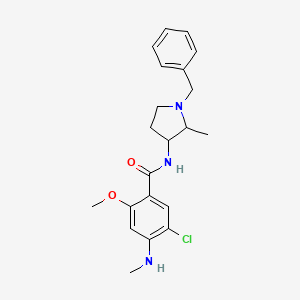
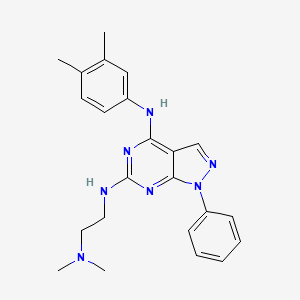
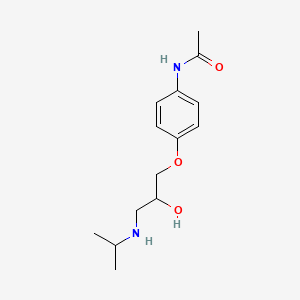
![(1R,9R,10S,12R,13S,14R,16S)-13-ethyl-8-methyl-15-propyl-8-aza-15-azoniahexacyclo[14.2.1.01,9.02,7.010,15.012,17]nonadeca-2,4,6-triene-14,18-diol;(2R,3R)-2,3,4-trihydroxy-4-oxobutanoate](/img/structure/B1678032.png)
